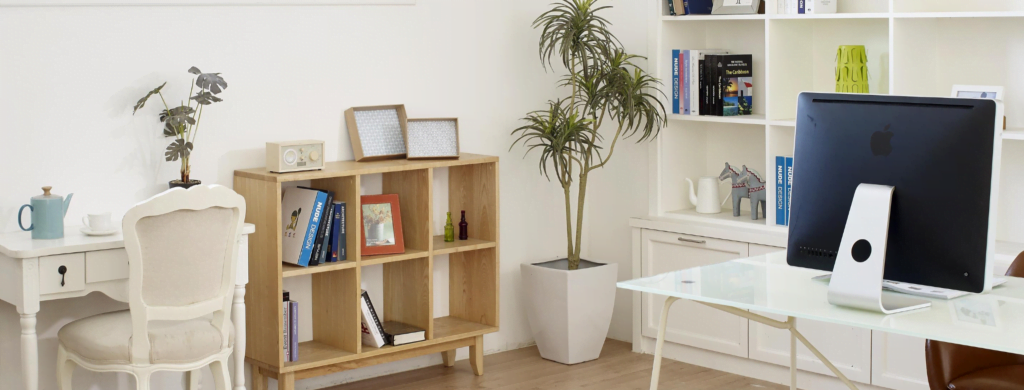How many times have you found yourself wishing that you were at home – snug, safe, and comfortable, while in the middle of a busy work day? For those whose companies belong to the 46% of American companies who have put into effect remote work policies since February of this year, their wish has been granted. In fact, based on the 2018 American Community Service (ACS) data by the Global Workplace Analytics, there are 5 million employees (or 3.6% of the US employee workforce), who work from home.
Coronavirus or not, the number of people who telecommute has been steadily rising since 2005. And one change brought about by the pandemic that a lot of people welcome is the opportunity to finally work in the comforts of their own homes.
The ease of lounging around in pajamas the whole day, though, is not the only perk that you can enjoy when working remotely. Following are the top 3 reported benefits that employees experience from this setup:
- Having a flexible schedule.
- Being able to work in any location.
- Doing away with commuting.
Business owners, on the other hand, also have the following advantages:
- An increase in employee productivity.
- A decrease in overhead costs.
But as much as the remote industry has its rewards, it is also an endeavor that brings a load of challenges as well. One such caveat of going remote that really hits home is finding the right balance between your personal life and your work life. Never before had the lines been more blurred concerning these two than today, and so we’ve compiled a list of things to watch out for when you’re working from home and of easy solutions to guide you through what is now known as the “new normal”.
Goodbye, alarm clock? Think again.
If you think that working from home means throwing out your alarm clock, then you’re in for a big surprise.

One of the main hurdles of working remotely is managing your time. Without the structure that following regular office hours brings, you can easily find yourself sleeping in or staying up late, which eventually leads to procrastination.
In most cases, the freedom that at-home work provides becomes double-edged. You may be free from the standard working hours, but also burdened from the consequences of not having them.
The solution?
Set a cohesive schedule for yourself and follow it. This way, you will be able to maximize your productivity even when working remotely. Imposing a structure on your work days will definitely help you keep your focus on tasks in spite of being in a more comfortable environment.
Additionally, a schedule will also allow you to take the necessary breaks to prevent burn out and keep you in the best of health. Stretching, walking around, and even just taking your eyes off the computer screen for a few minutes a day will ensure that you stay productive throughout the day. Most importantly, a schedule will keep you from doing overtime work and procrastinating.
Maintaining a routine, therefore, is more than ever imperative in work-at-home situations to keep you and your business running smoothly as possible.
Cubicle-free, but at what cost?
Remember that feeling when you first got assigned to a cubicle in your office? Or that urge to bring out even a silly vacation photo on your table just to make it “yours”? It’s the same feeling when working at home, only in reverse. Being in a room full of things that spell comfort and home while in the midst of work deadlines can easily make you lose focus. What’s more, being out in the open exposes you from other sources of distraction, such as those coming from your roommates or family members. Not having a clear distinction between your workspace and personal space can wreak havoc to that neat mental division that not only signals to those around you that you are not to be disturbed, but also enables you to switch from “work” to “relax” modes.

The fix?
Arrange a separate physical space for working that will create a boundary between your personal and work areas. May it be a spare bedroom or a secluded corner in your house, having a dedicated “home office” will do wonders for you and those you live with. Furthermore, a locked door will suitably keep out unwanted sources of distraction, as well as sustain your attention to the duties and responsibilities at hand. This will also come in handy when you have meetings and presentations. Aside from noise-cancelling earphones, having your own area for work is an effective deterrent from sudden outbursts from little ones, furry ones, and the not-so-little nor furry ones, most especially when you’re in the middle of an important phone call. Having a place to go to, even when at home, hence prepares you and those around you for the day ahead; just as it trains your mind and body to switch off when you finish your shift.
When technical difficulties become more difficult.
One of the biggest misconceptions about transitioning to remote work is that it is as easy as uprooting yourself from your corner in the office to a corner of your house. Unfortunately, it takes so much more than lugging around your laptop and sitting in your living room to successfully navigate this new normal.

At home, there is always the possibility of devices falling off the coffee table or falling into the hands of curious children. Aside from this, without the support of your company’s IT department, there is a danger for confidential information to be leaked or to be taken advantage of by cyber criminals.
Another point to consider is the stability of the Wi-Fi connection in your area, as well as your own capability of troubleshooting should the need arise.
The key?
Set aside additional budget to cover an increase in IT needs for you and your employees. Reach out to your vendor-support team to familiarize yourself with the policies regarding their services and supplies, as well as to make sure that they will be available for support should you or employees require it.
Furthermore, this is also the best time to strengthen your security tools, particularly your company’s VPN connection and license.
Likewise, ensure that your company has a secure enough bandwidth to enable VPN and remote-desktop access for everyone. If there is any lesson to be learned from the pandemic, it is that every business owner should be armed with a disaster recovery plan to ensure that operations continue even when there are unexpected events.
By being prepared to face any eventuality, you lessen the stress that transitioning to remote work brings to you and your business.
Teamwork makes the dream work.
If you thought that those short conversations by the water cooler or meetings that should have been an email were a waste of time, then you’re in for a rude awakening.

These interactions, no matter how trivial or unnecessary they once seemed, actually contribute in forming bonds that help people perform well together. With remote work in full swing, though, face-to-face interaction among workmates becomes limited to none at all.
And whether in the day-to-day operations or in the midst of a special project, the effort to make sure that you and your team members are aligned is all the more challenging for any business owner or manager in this setting.
Moreover, with communication limited to emails, text messages, and video calls, there are no non-verbal cues that we can rely on to better understand each other.
A remote setting, thus, makes it harder for us to connect with each other and foster good working relationships that are essential for any team to work effectively.
The answer?
Make collaboration and communication your top priority in your company by securing the basics such as video conferencing, phones, file sharing, and team messaging. Keep the communication lines open by taking advantage of online tools. Use a collaboration app or software to keep everyone in your team in the loop while minimizing the chance of having lost messages, spam, and nonwork related distractions. Establish guidelines for team members to follow, such as when one should be available for information and updates, as well as for meetings. And because virtual communication is yet to be effective as face-to-face interaction, verifying deliverable and objectives after every meeting is essential to ensure that everyone in your team is on the same page. Forging a connection among individuals in the same room already has its challenges and aiming for one where team members are scattered all over the globe may even be a hundred times more difficult, but definitely not impossible to do. Lead by example for your employees to follow by being responsive and reliable, promoting transparency and using the right collaboration tools to ensure that your team works for the same goals, no matter where you all are.
Table for only one?
We are social animals. And with remote work, there is little to no opportunity for “forced interaction” with others on a day-to-day basis, such as sharing a ride up the elevator or sitting beside each other during a meeting. Not being physically around people also means missing out on the kind of energy you get from being near ambitious and driven co-workers. Without this, one can easily lose sight of long-term goals, slip into complacency, and lack motivation to face challenges and do more rewarding work. Remote work also implies spending most of your time by yourself, which can be lonely and isolating.

The strategy?
Anticipate this change and prepare for it.
Working at home is not an excuse to feel cocooned and isolated. Reach out and put yourself out there by scheduling video conference calls, not only with your colleagues and employees, but also with your friends and industry peers. Apart from checking up on your business, it is also imperative that you set aside time to touch base with the people you can have fun and relax with.
What’s more, take this chance to stay relevant and up-to-date by joining industry-specific social media groups, as well as those for like-minded individuals and entrepreneurs.
Additionally, a healthy diet and exercise keep moods at bay. Engage in activities such as hiking and biking that will take you outdoors where good ventilation and beautiful scenery can do wonders for your physical and mental health.
Lastly, always make sure that you get up each morning, bathe, dress up, and show up ready for work every day to maintain a sense of purpose and remind yourself that you are on your way to achieving your goals.
All-in-one shop no more.
One of the drawbacks of shifting to remote work is the necessity for it to be an “all-in-one shop” wherein you have to have everything at your disposal for your business to run smoothly.
Aside from having adequate supplies and devices, remote workers are most likely to perform duties outside of their job description and beyond their skills. Not only can these be difficult and time-consuming for a business owner, you also run the risk of losing important deals or closing substantial sales.
An entrepreneur can easily be overwhelmed by day-to-day tasks that could hinder him from performing the duties that directly influence the growth of his company. And in a remote economy, this situation is more likely to intensify, with businesses being scaled down while people are expected to step up.

Our tip?
Get organized. Plan your days well, make sure that you have adequate supplies and support, use the right online tools to manage your projects, and systematize your work processes and stay motivated in achieving your goals.
Remote work need not be complex nor cause you undue stress. It is actually cost-effective and, with the current pandemic, the safer way to do business.
In fact, aside from the aforementioned suggestions we have put together for you, one of the best ways to ensure that you maintain the balance between your work and personal life while working from home is by getting help from a virtual assistant.
A virtual assistant, or a VA, empowers you to take control of your professional and personal life because he or she can assist you in managing, overseeing, and accomplishing tasks that often come in the day-to-day operations of your business, thereby allowing you to have the time to focus on your personal life.
Now is the best time to make that investment for your business and yourself. Get quality virtual assistant services now and let OkayRelax show you how.
